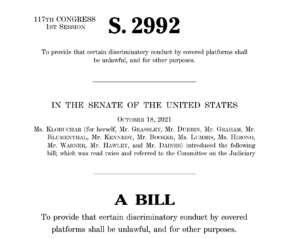I read much but finished little in December. Sometimes that happens—I have a tendency to have too many books going at once.
Amazon’s Antitrust Paradox
In an effort to better my understanding of monopolies and antitrust, I picked up an article1 by Lina Khan, published in 2017, a few years before her bait and switch nomination to the Federal Trade Commission in early 2021. At that time, she was nominated to a seat on the FTC, then confirmed as a Commissioner with bipartisan approval and then was rapidly (and unexpectedly) tapped to lead the agency as Chair. It’s not clear that her approval would have been so strong had it been known from the beginning that she was being put forward as the Chair.
I read it slowly since I was unfamiliar with many of the legal concepts and jargon in her Yale Law Journal note. And I slowed down even further as I found myself unexpectedly agreeing with her arguments. My synopsis is this: we can’t currently levy traditional antitrust policies against Amazon, largely because Amazon is intentionally structured to not trigger the characteristic defining today’s antitrust doctrine: consumer welfare measured by low consumer prices.2
And it’s true: Amazon allows consumers to acquire more stuff, more cheaply, (and more quickly) than probably at any other time in history.
And yet, by creating a concentrated market structure with enormous vertical integration, Amazon’s conduct is decidedly anticompetitive.
This is where Khan argues most strongly, showing Amazon’s outsized influence in (one of my favorite commodities) books. From reselling used books (AbeBooks) to publishing new ones (Amazon Publishing), from self-publishing (Kindle Direct) to collecting crowd-sourced reviews (Goodreads), audio books (Audible) and e-reader hardware (Kindle), comic books (ComiXology) and educator-to-student e-books (Whispercast) and even connecting authors and narrators for audiobooks (ACX), Amazon is vertically integrated at every level of book publishing.
Khan argues that “this trend has cost authors and readers alike, leaving writers with fewer paths to market and readers with a less diverse marketplace” (p. 766). One can argue that Kindle direct gives writers an additional (self-publishing) path to market but I think this is mostly an illusion since many (perhaps most) self-published authors lack the platform, know-how and resources to properly market their book and see any realistic sales, distribution or exposure. Additionally, by lowering (eliminating?) the barrier to entry (through self-publishing), an enormous quantity of low-quality works are published. Without the mentoring, coaching and resources of a traditional publishing house, these low-quality works will likely remain low-quality.3
I don’t know that I can precisely place a limit or size on where vertical integration starts to become anticompetitive. Khan struggles with that in 2017, too. But she knows it’s there, quoting Senator George in lamenting “that if large-scale industry were allowed to grow unchecked, it would ‘crush out all small men, all small capitalists, all small enterprises'” (p. 742). In quite a few places, she identifies this issue as a one of freedom, for example, noting that “concentration of economic power also consolidates political power, . . . undermining individual and business freedom” (p. 740).
I think E.B. White would agree. Although arguing mostly about the Press, much of what he advocates can be easily transferred to books and publishing. Lots of books, lots of publishers, lots of viewpoints. And let the readers decide.4
However, Khan regularly weakens her argument by regularly referring back to predatory pricing doctrine. If she wants to argue for reverting back to 1890’s Sherman Act policies, reminding the reader that consumers are enjoying lower prices from Amazon today is not helpful.
Conclusion
Amazon’s vertical integration (indeed, ownership of much of the supply-chain, from top to bottom) does indeed benefit consumers in lower prices. But Khan argues that we’re assessing this monopoly with the wrong measuring stick5 welfare but competitive markets (p. 737).] and we should instead be looking at harm to third-party sellers, the decrease in viewpoint diversity of publishing, how Amazon’s rivals are controlled and other anticompetitive behavior and structures.
Books and articles read:
Austen, J. (2020). Mansfield Park. Mint Editions.
Carrión, J. (2017). Against Amazon: Seven Arguments/One Manifesto. (P. Bush, Trans.). Biblioasis: Windsor, Ontario.
Güiraldes, Ricardo. (1966). Don Segundo Sombra: Shadows on the pampas. (de Onís, Harriet, Trans.). New American Library.
Khan, L. M. (2017). Amazon’s Antitrust Paradox. The Yale Law Journal, 126(710), 710–805.
- HTML and PDF versions available ↩
- If that emphasis on “harm to consumer welfare” as today’s defining characteristic of monopolistic behavior is new to you, don’t be surprised. Reading her Note required me to revisit many of my long-held thoughts on monopolies and anti-trust doctrine. ↩
- If it appears that I’m arguing for a happy medium between the anarchy of self-publishing and the monolith of Amazon, I am. ↩
- In his comments on the press from On Democracy, he notes that “the press in our free country is reliable and useful not because of its good character but because of its great diversity. As long as there are many owners, each pursuing his own brand of truth, we the people have the opportunity to arrive a the truth and to dwell in the light. The multiplicity of ownership is crucial. It’s only when there are few owners . . . that the truth becomes elusive (White & White, 2020, p. 211). ↩
- “Antitrust law and competition policy should promote not [consumer ↩


